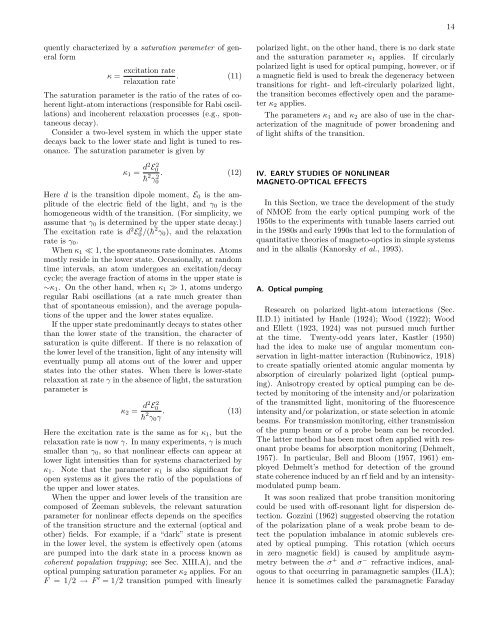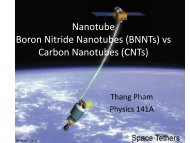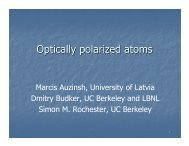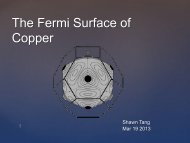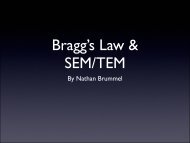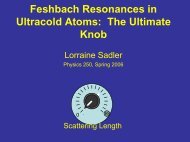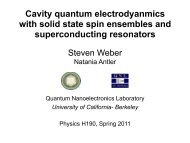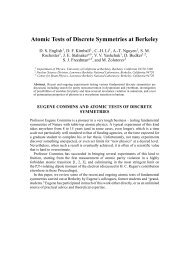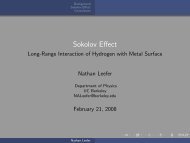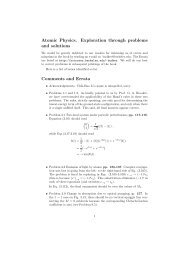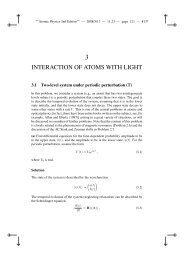Resonant nonlinear magneto-optical effects in atomsâ - The Budker ...
Resonant nonlinear magneto-optical effects in atomsâ - The Budker ...
Resonant nonlinear magneto-optical effects in atomsâ - The Budker ...
You also want an ePaper? Increase the reach of your titles
YUMPU automatically turns print PDFs into web optimized ePapers that Google loves.
14<br />
quently characterized by a saturation parameter of general<br />
form<br />
κ =<br />
excitation rate<br />
relaxation rate . (11)<br />
<strong>The</strong> saturation parameter is the ratio of the rates of coherent<br />
light-atom <strong>in</strong>teractions (responsible for Rabi oscillations)<br />
and <strong>in</strong>coherent relaxation processes (e.g., spontaneous<br />
decay).<br />
Consider a two-level system <strong>in</strong> which the upper state<br />
decays back to the lower state and light is tuned to resonance.<br />
<strong>The</strong> saturation parameter is given by<br />
κ 1 = d2 E0<br />
2<br />
¯h 2 . (12)<br />
γ0<br />
2<br />
Here d is the transition dipole moment, E 0 is the amplitude<br />
of the electric field of the light, and γ 0 is the<br />
homogeneous width of the transition. (For simplicity, we<br />
assume that γ 0 is determ<strong>in</strong>ed by the upper state decay.)<br />
<strong>The</strong> excitation rate is d 2 E0 2 /(¯h 2 γ 0 ), and the relaxation<br />
rate is γ 0 .<br />
When κ 1 ≪ 1, the spontaneous rate dom<strong>in</strong>ates. Atoms<br />
mostly reside <strong>in</strong> the lower state. Occasionally, at random<br />
time <strong>in</strong>tervals, an atom undergoes an excitation/decay<br />
cycle; the average fraction of atoms <strong>in</strong> the upper state is<br />
∼κ 1 . On the other hand, when κ 1 ≫ 1, atoms undergo<br />
regular Rabi oscillations (at a rate much greater than<br />
that of spontaneous emission), and the average populations<br />
of the upper and the lower states equalize.<br />
If the upper state predom<strong>in</strong>antly decays to states other<br />
than the lower state of the transition, the character of<br />
saturation is quite different. If there is no relaxation of<br />
the lower level of the transition, light of any <strong>in</strong>tensity will<br />
eventually pump all atoms out of the lower and upper<br />
states <strong>in</strong>to the other states. When there is lower-state<br />
relaxation at rate γ <strong>in</strong> the absence of light, the saturation<br />
parameter is<br />
κ 2 = d2 E 2 0<br />
¯h 2 γ 0 γ . (13)<br />
Here the excitation rate is the same as for κ 1 , but the<br />
relaxation rate is now γ. In many experiments, γ is much<br />
smaller than γ 0 , so that <strong>nonl<strong>in</strong>ear</strong> <strong>effects</strong> can appear at<br />
lower light <strong>in</strong>tensities than for systems characterized by<br />
κ 1 . Note that the parameter κ 1 is also significant for<br />
open systems as it gives the ratio of the populations of<br />
the upper and lower states.<br />
When the upper and lower levels of the transition are<br />
composed of Zeeman sublevels, the relevant saturation<br />
parameter for <strong>nonl<strong>in</strong>ear</strong> <strong>effects</strong> depends on the specifics<br />
of the transition structure and the external (<strong>optical</strong> and<br />
other) fields. For example, if a “dark” state is present<br />
<strong>in</strong> the lower level, the system is effectively open (atoms<br />
are pumped <strong>in</strong>to the dark state <strong>in</strong> a process known as<br />
coherent population trapp<strong>in</strong>g; see Sec. XIII.A), and the<br />
<strong>optical</strong> pump<strong>in</strong>g saturation parameter κ 2 applies. For an<br />
F = 1/2 → F ′ = 1/2 transition pumped with l<strong>in</strong>early<br />
polarized light, on the other hand, there is no dark state<br />
and the saturation parameter κ 1 applies. If circularly<br />
polarized light is used for <strong>optical</strong> pump<strong>in</strong>g, however, or if<br />
a magnetic field is used to break the degeneracy between<br />
transitions for right- and left-circularly polarized light,<br />
the transition becomes effectively open and the parameter<br />
κ 2 applies.<br />
<strong>The</strong> parameters κ 1 and κ 2 are also of use <strong>in</strong> the characterization<br />
of the magnitude of power broaden<strong>in</strong>g and<br />
of light shifts of the transition.<br />
IV. EARLY STUDIES OF NONLINEAR<br />
MAGNETO-OPTICAL EFFECTS<br />
In this Section, we trace the development of the study<br />
of NMOE from the early <strong>optical</strong> pump<strong>in</strong>g work of the<br />
1950s to the experiments with tunable lasers carried out<br />
<strong>in</strong> the 1980s and early 1990s that led to the formulation of<br />
quantitative theories of <strong>magneto</strong>-optics <strong>in</strong> simple systems<br />
and <strong>in</strong> the alkalis (Kanorsky et al., 1993).<br />
A. Optical pump<strong>in</strong>g<br />
Research on polarized light-atom <strong>in</strong>teractions (Sec.<br />
II.D.1) <strong>in</strong>itiated by Hanle (1924); Wood (1922); Wood<br />
and Ellett (1923, 1924) was not pursued much further<br />
at the time. Twenty-odd years later, Kastler (1950)<br />
had the idea to make use of angular momentum conservation<br />
<strong>in</strong> light-matter <strong>in</strong>teraction (Rub<strong>in</strong>owicz, 1918)<br />
to create spatially oriented atomic angular momenta by<br />
absorption of circularly polarized light (<strong>optical</strong> pump<strong>in</strong>g).<br />
Anisotropy created by <strong>optical</strong> pump<strong>in</strong>g can be detected<br />
by monitor<strong>in</strong>g of the <strong>in</strong>tensity and/or polarization<br />
of the transmitted light, monitor<strong>in</strong>g of the fluorescence<br />
<strong>in</strong>tensity and/or polarization, or state selection <strong>in</strong> atomic<br />
beams. For transmission monitor<strong>in</strong>g, either transmission<br />
of the pump beam or of a probe beam can be recorded.<br />
<strong>The</strong> latter method has been most often applied with resonant<br />
probe beams for absorption monitor<strong>in</strong>g (Dehmelt,<br />
1957). In particular, Bell and Bloom (1957, 1961) employed<br />
Dehmelt’s method for detection of the ground<br />
state coherence <strong>in</strong>duced by an rf field and by an <strong>in</strong>tensitymodulated<br />
pump beam.<br />
It was soon realized that probe transition monitor<strong>in</strong>g<br />
could be used with off-resonant light for dispersion detection.<br />
Gozz<strong>in</strong>i (1962) suggested observ<strong>in</strong>g the rotation<br />
of the polarization plane of a weak probe beam to detect<br />
the population imbalance <strong>in</strong> atomic sublevels created<br />
by <strong>optical</strong> pump<strong>in</strong>g. This rotation (which occurs<br />
<strong>in</strong> zero magnetic field) is caused by amplitude asymmetry<br />
between the σ + and σ − refractive <strong>in</strong>dices, analogous<br />
to that occurr<strong>in</strong>g <strong>in</strong> paramagnetic samples (II.A);<br />
hence it is sometimes called the paramagnetic Faraday


